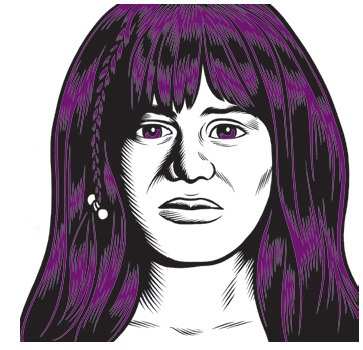Phoebe Gloeckner began her career as a medical illustrator who published comics on the side in volumes such as Twisted Sisters: A Collection of Bad Girl Art, and also did experimental illustration for work such as J. G. Ballard’s The Atrocity Exhibition. In 1998, she published her first book, A Child’s Life and Other Stories, a comics collection that has at its center several hard-hitting semiautobiographical stories featuring a character named Minnie. Her next book, The Diary of a Teenage Girl: An Account in Words and Pictures (2002), takes place in 1970s San Francisco and focuses on one year of fifteen-year-old Minnie’s life—a year in which she starts an affair with her mother’s predatory boyfriend, gets kicked out of several schools, runs away to join Polk Street’s gay and drug subculture, and draws many comics. Diary, the most unabashed record of teenage sexuality I can think of, is a remarkable formal object, roughly half Gloeckner’s actual diary from the time and half narrative she formed as an adult. The story moves forward in both prose and comics sections, seamlessly alternating back and forth, while also featuring many spot and full-page illustrations. (The New York Times wrote that Gloeckner “is creating some of the edgiest work about young women’s lives in any medium.”)
Gloeckner’s current project is another formally experimental take on young women’s lives, but it focuses on the murders of women in Ciudad Juárez, Mexico. Gloeckner first traveled to Juárez in 2003 to research her “graphic reportage,” La Tristeza, which was commissioned for the volume I Live Here, edited by the actress Mia Kirshner (Pantheon, 2008). Gloeckner started off drawing scenes of murder. She eventually developed a three-dimensional sculpting and modeling technique whereby she poses dolls that she creates—they are felted wool with wire armatures, and have styled hair and meticulously detailed clothes Gloeckner sews—in scenes in elaborate quarter-scale sets. She photographs them and then digitally integrates the doll faces with human features. The images are at once fascinating and highly unsettling. Currently an art professor at the University of Michigan, Gloeckner was inspired to embark upon a larger project focusing on the Juárez–El Paso border area. She has visited Juárez more than a dozen times in the past several years, and made close connections with the family of a murdered girl, Maria Elena Chávez Caldera, who remains the inspiration for her forthcoming book.
Our conversation took place in her Ann Arbor studio, where she builds and photographs her sets—and where her three-legged cat, Pipsqueak, hides out—for two days in December 2009. Gloeckner’s studio occupies the top floor of her house. We were...
You have reached your article limit
Sign up for a digital subscription and continue reading all new issues, plus our entire archives, for just $1.50/month.
Already a subscriber? Sign in





